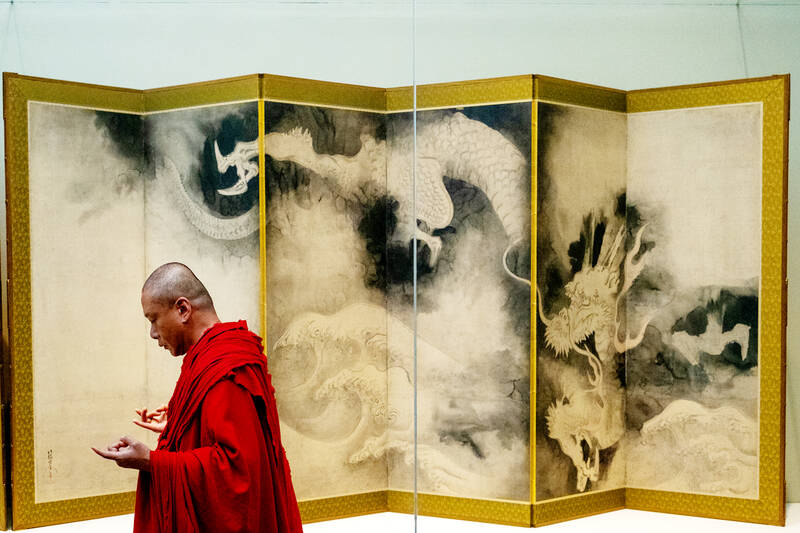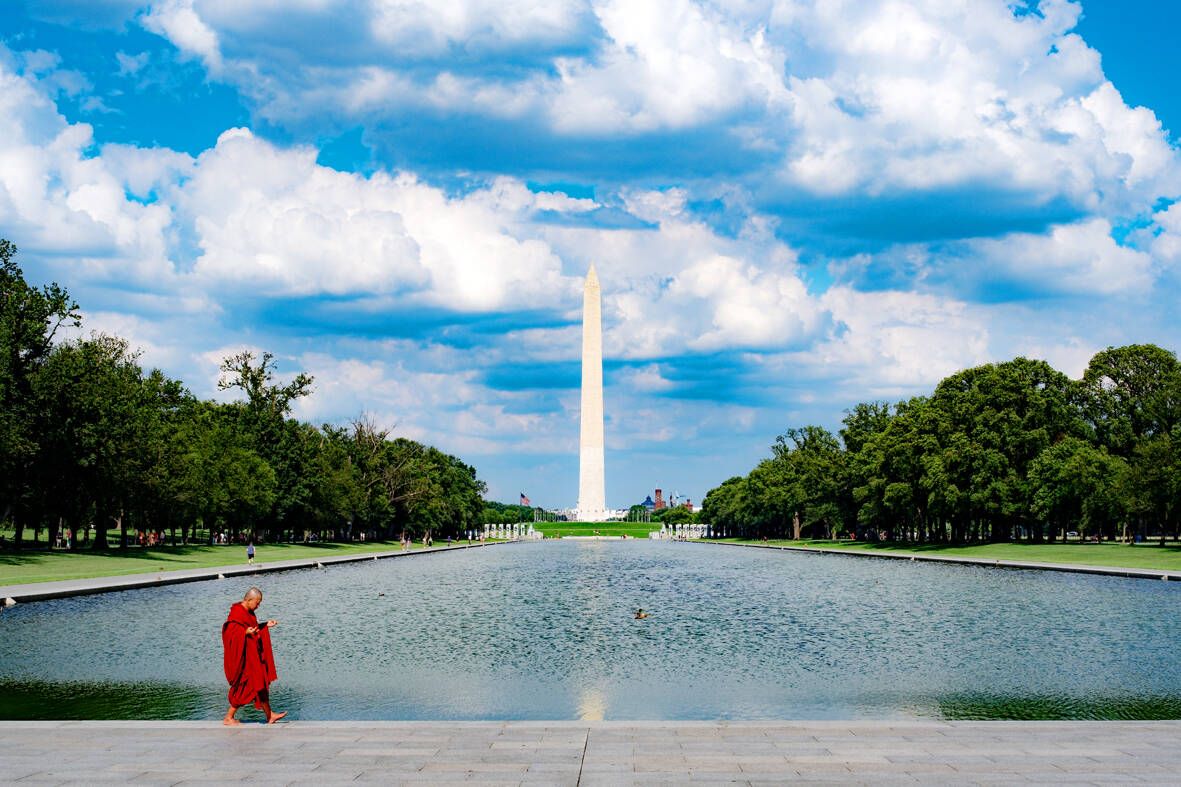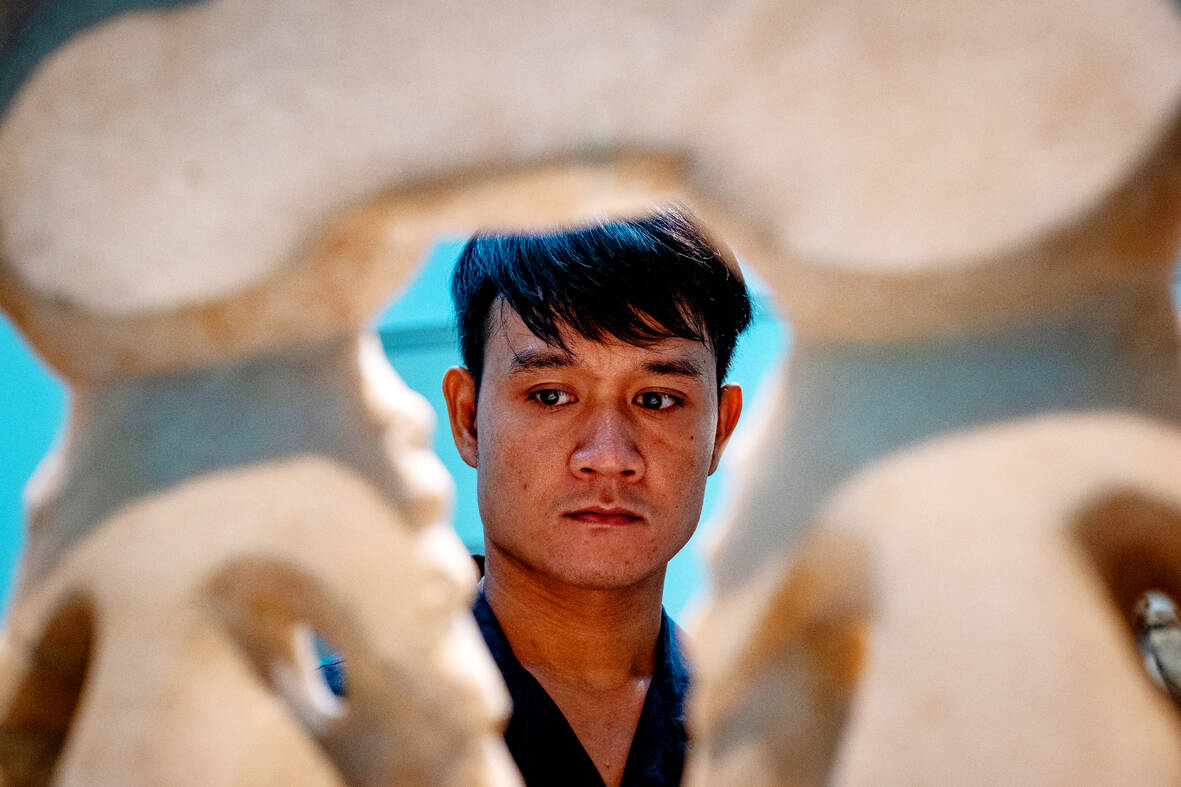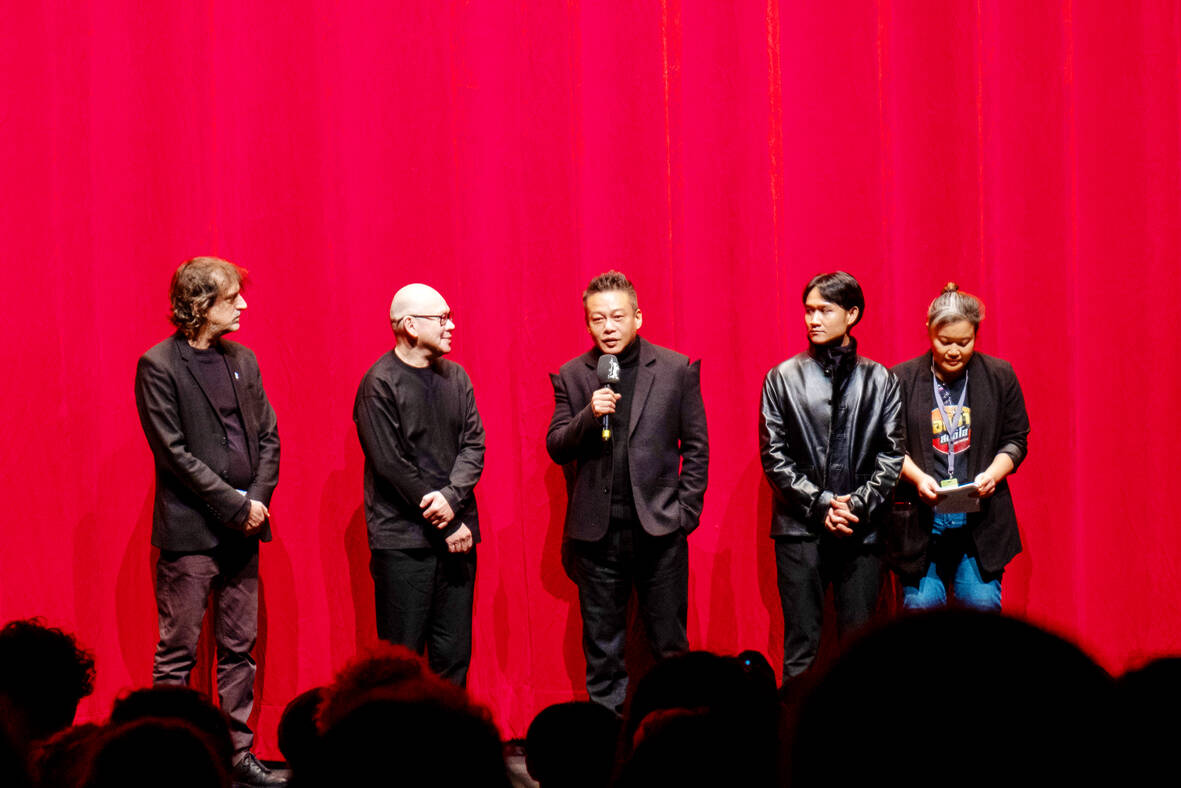It is now just over a decade since Tsai Ming-liang (蔡明亮), the most famous auteur of Taiwan’s New Wave cinema still working, declared he would stop making movies. After receiving the Grand Jury prize at the Venice Film Festival in 2013 for Stray Dogs (郊遊), a stark and roving depiction of a homelessness in Taipei, “I announced that I no longer felt like making films that involved selling tickets to movie theaters,” Tsai told me last week in a video call from Berlin, where he was debuting a new work, Abiding Nowhere (無所住), at the Berlin Film Festival.
“I was extremely bored,” he explained. “The whole idea of the film industry made me feel extremely bored. You have to create a proposal, write a script, get funding — none of this was interesting to me anymore.”
Tsai, now 66, has also claimed that feature filmmaking had become too exhausting.

Photo courtesy of Homegreen Films
“I still wanted to make movies, but I didn’t want to do it for audiences,” he continued. “So at the time I decided to stop making narrative films. But at the same time, I didn’t know what I could do.”
Now 10 years later, Tsai is still a major celebrity on the international arthouse film circuit, but his creative output has taken on a new direction. On the creative side, he has completely dispensed with script, making films that fall somewhere in the spectrum between experimental cinema and video art — Taiwanese critic Hongjohn Lin (林宏章) once described a Tsai work from this period as “post-cinema film installation.”
Also, instead of operating strictly within the system of commercial cinema — and yes, even art house films operate according to a system of investors, producers and film sales agents — Tsai has moved towards a model of direct, institutional patronage.

Photo courtesy of Homegreen Films
In many ways, the award-winning Taiwanese director has come to operate much like a star artist of the contemporary art world. Funding for new projects has since 2009 come from some of the world’s top museums, including the Louvre and Pompidou Center in Paris and, for Tsai’s latest work, the Smithsonian Museum in Washington DC. At the same time, his films have screened in a combination of arthouse cinemas and been installed in museum galleries.
The newest, Abiding Nowhere, a commission of the Smithsonian’s National Museum of Asian Art, just saw its world premiere on Feb. 20 at the Berlin Film Festival and will screen at the Smithsonian in Washington DC on Friday.
The film is the tenth installment in Tsai’s Walker series, which, begun in 2012, presents the figure of a monk in burnt orange robes walking in glacially slow movements through the streets and crowds of various world cities. To date, these have included Taipei, Paris, Marseille and Tsai’s hometown of Kuching, Malaysia.

Photo courtesy of Homegreen Films
ITINERANT MONK
In this latest 79-minute iteration, the monk, played by the actor who has starred in every one of Tsai’s films since 1992, Lee Kang-sheng (李康生), inches his way through Washington DC’s familiar national monuments, several Smithsonian galleries, the city’s neoclassical train station and several perplexingly anonymous locales. Two to six-minute takes of the monk’s movements are intercut with fixed camera shots of various interior spaces and the solitary movements of a figure described by Tsai as an “everyman,” played by Anong Houngheangsy.
The premise of the itinerant monk, Tsai said, was inspired by the classic Chinese tale Journey to the West (西遊), in which Xuanzang, a seventh century monk, undertakes an epic journey from China to India to bring back Buddhist scriptures and introduce the religion at the Tang court.

Photo courtesy of Homegreen Films
Unlike Xuanzhang’s mythical tale, however, Tsai’s Walker films offer a journey without destination. There is neither the acquisition of wisdom nor the implication of a return journey. There are in fact no events at all. There is simply the stark juxtaposition between the monk, who’s very slowness imbues him with a sense of religious timelessness, and the fast flowing world that swarms around him, an everyday reality that seems by comparison incredibly frivolous and mundane.
Though Tsai denies being a devout Buddhist and takes the film’s name from a passage in the Diamond Sutra, an ancient Buddhist scripture, the film acts as striking metaphor for the Buddhist concept of sunyata, or the fundamental emptiness of all phenomena.
The Smithsonian commissioned Abiding Nowhere to celebrate the 2023 centennial of the National Museum of Asian Art (NMAA), an institution which mainly houses premodern works.
‘UNCONVENTIONAL IDEAS’
However, explained Tom Vick, NMAA’s film curator, via an email interview, “We were encouraged to come up with big and unconventional ideas for celebrating that milestone. The driving force was to look forward to the next 100 years, and think about how the museum could transform itself — to become more engaging and welcoming to contemporary audiences, and think about how audiences can engage with our collection in new ways, instead of thinking of them as objects on pedestals.”
“We have a sizable trove of ancient Buddhist art in our collection. I liked the idea of juxtaposing those objects with Tsai’s aesthetic,” he said.
In many ways, Tsai’s Walker films represent a new apotheosis of the filmmaker’s trademark “slow cinema,” a term frequently used to describe his style of long takes, few cuts, limited dialogue and a stationary camera.
Even in his early narrative films, Tsai used legendary long takes (always beautifully framed) in which it seems that not much happens, though the slightest of actions do in fact take place. These have included lengthy shots, like that of a man staring at a fish tank, or a woman sitting on a bed eating a banana, as in What Time is it There? (你那邊幾點?, 2001), which portrays a man engaging in a sort of anti-love affair while he and his mother deal with the death of his father. Tsai became famous for such films, which present a cinematic reality in which emotions are seldom expressed, sexuality is forever frustrated and human connections are always mistimed.
Tsai has been loved and hated for this combination of slowness and what one New York Times critic described as “Asian miserablism,” but if there is one area where he has perhaps been underappreciated, it is as a master of visual metaphor.
Tsai’s cinematic tropes have ranged from campy and absurd, as a cabaret musical scene that erupts out of the toilet stalls of a public restroom in The Wayward Cloud (天邊一朵雲, 2005), to the psychologically pregnant, as in that moment in The Hole (洞, 1998) when a physical space suddenly opens between two apartments in a quarantined building, forcing an uneasy relationship between a pair of stranger occupants.
‘SLOW LOOKING’
Now, in Tsai’s post-narrative phase, the Walker series has crystallized the two elements of slow cinema and the visual metaphor into a single visual concept, that of a monk who moves so slowly that a regular-speed world seems to fast-forward around him. Ironically or not, slowness, or slowing down, has become the concept that Tsai now endeavors to express.
“The main thing that appeals to me,” said Vick, “is that [the Walker films] encourage a kind of ‘slow looking.’ The durations of the shots and Lee Kang-sheng’s slow movements as the Walker result, for me, in an almost meditative state, a way of watching a film that is different from normal narrative films.”
For Tsai, this has come in parallel with a slowing down in his own personal life. He and Lee, his leading man for more than three decades, have both dealt with illness during the last decade, and they now live a sedate life together in a once-derelict apartment on a hilltop in the mountains just outside of Taipei.
When I asked Tsai about his spirituality, he joked, “I don’t meditate. But I do space out.”
“These past few years,” he continued, “I don’t watch that many movies and I don’t read that much. Often I just stay home not doing anything.”
Tsai also noted that in a personal sense, his entire oeuvre has been an extended gaze at Lee’s body and how it has changed over time. Those changes have now seen Lee move through multiple life stages, beginning from a wayward youth who falls in with petty thieves in Tsai’s first feature film, Rebels of a Neon God (青少年哪吒, 1992), then into sexual awakening and maturity in at least 10 intermediate films, and now the worldly renunciation of a monk in the Walker series.
In many ways, the Walker films feel like a coda to both Tsai’s career and Lee’s 30-year character arc.
When I mentioned this, Tsai paused for thought, before replying, “I think, this monk, this Walker, he’s also kind of like a wayward youth. They’re similar in that they’re both rebellious.”
But what was the monk’s rebellion? The more I talked to Tsai it became clear that on one level these films represent Tsai’s personal rebellion against the commercial film industry. And that act of rebellion operates according to one very simple strategy — slowness.

In the March 9 edition of the Taipei Times a piece by Ninon Godefroy ran with the headine “The quiet, gentle rhythm of Taiwan.” It started with the line “Taiwan is a small, humble place. There is no Eiffel Tower, no pyramids — no singular attraction that draws the world’s attention.” I laughed out loud at that. This was out of no disrespect for the author or the piece, which made some interesting analogies and good points about how both Din Tai Fung’s and Taiwan Semiconductor Manufacturing Co’s (TSMC, 台積電) meticulous attention to detail and quality are not quite up to

April 21 to April 27 Hsieh Er’s (謝娥) political fortunes were rising fast after she got out of jail and joined the Chinese Nationalist Party (KMT) in December 1945. Not only did she hold key positions in various committees, she was elected the only woman on the Taipei City Council and headed to Nanjing in 1946 as the sole Taiwanese female representative to the National Constituent Assembly. With the support of first lady Soong May-ling (宋美齡), she started the Taipei Women’s Association and Taiwan Provincial Women’s Association, where she

Chinese Nationalist Party (KMT) Chairman Eric Chu (朱立倫) hatched a bold plan to charge forward and seize the initiative when he held a protest in front of the Taipei City Prosecutors’ Office. Though risky, because illegal, its success would help tackle at least six problems facing both himself and the KMT. What he did not see coming was Taipei Mayor Chiang Wan-an (將萬安) tripping him up out of the gate. In spite of Chu being the most consequential and successful KMT chairman since the early 2010s — arguably saving the party from financial ruin and restoring its electoral viability —

It is one of the more remarkable facts of Taiwan history that it was never occupied or claimed by any of the numerous kingdoms of southern China — Han or otherwise — that lay just across the water from it. None of their brilliant ministers ever discovered that Taiwan was a “core interest” of the state whose annexation was “inevitable.” As Paul Kua notes in an excellent monograph laying out how the Portuguese gave Taiwan the name “Formosa,” the first Europeans to express an interest in occupying Taiwan were the Spanish. Tonio Andrade in his seminal work, How Taiwan Became Chinese,